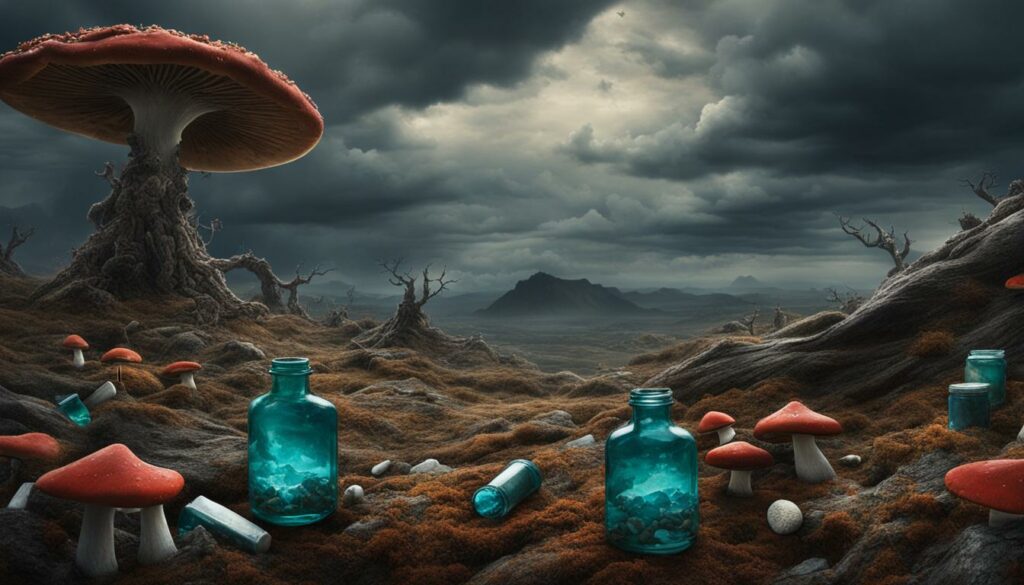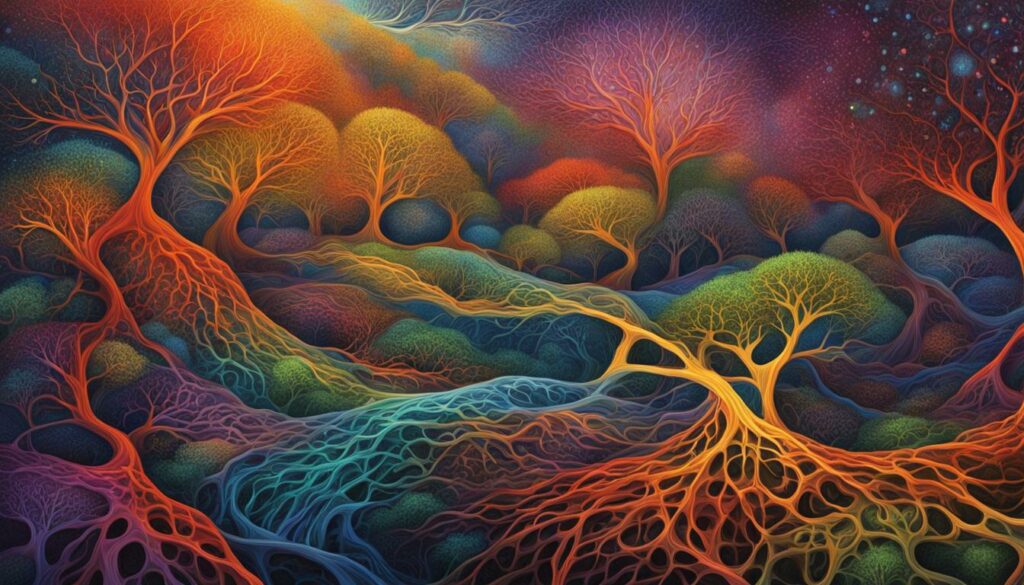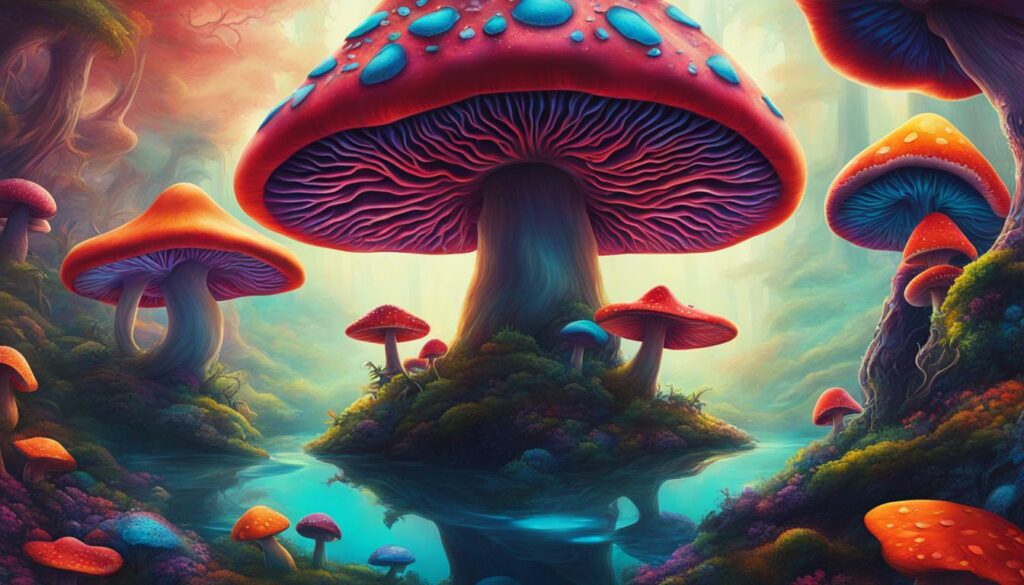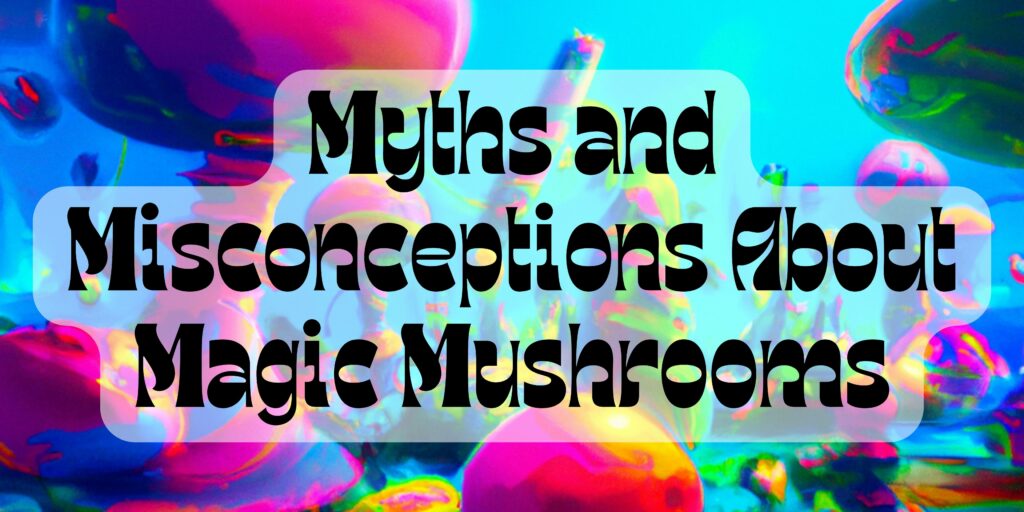Psychedelic drugs have gained attention and curiosity, particularly around the comparison of two popular substances: “magic” mushrooms (shrooms) and LSD (acid). While both shrooms and LSD fall under the category of hallucinogens, they have distinct differences in terms of their effects, origins, and methods of use. Let’s explore the world of shrooms vs LSD and delve into their similarities and differences.
- Shrooms and LSD are popular psychedelics with distinct characteristics and effects.
- Both substances can induce hallucinations and similar side effects, but differ in their origins and methods of use.
- Caution should be exercised when using psychedelics, considering the potential risks and benefits, as well as individual factors such as mental health history.
- Further research is needed to fully understand the effects of psychedelics on neuroplasticity and their therapeutic potential.
- Shrooms and LSD can have both positive and negative effects, and it’s important to approach their use with awareness and responsibility.
What Are LSD and Shrooms?
LSD and shrooms are two distinct psychedelic substances that have become popular in recent years. LSD, also known as acid, is a synthetic drug derived from a substance found in ergot, a fungus that grows on rye. It is classified as a hallucinogen and is known for its powerful effects on perception and consciousness.
On the other hand, shrooms, also referred to as magic mushrooms, are natural fungi that contain psilocybin, a psychoactive and hallucinogenic compound. Psilocybin is found in various species of mushrooms and is responsible for the mind-altering effects experienced when they are consumed. Shrooms have been used for centuries in spiritual and cultural practices.
Both LSD and shrooms are classified as Schedule I drugs due to their high potential for abuse and lack of accepted medical use, according to the United States Drug Enforcement Administration (DEA). It is important to note that the use of these substances, especially in high doses, carries risks and can have significant psychological effects.
| LSD | Shrooms |
|---|---|
| Synthetic drug | Naturally occurring fungi |
| Derived from ergot fungus | Contains psilocybin |
| Potent hallucinogen | Psychoactive compound |
The Effects of LSD and Shrooms
When it comes to psychedelics like LSD and shrooms, both substances are known to induce a range of effects that alter perception and consciousness. These effects can be profound and vary from person to person. Here, we explore the distinct experiences that LSD and shrooms offer.
Visual and Sensory Hallucinations
One of the primary effects of both LSD and shrooms is the onset of visual and sensory hallucinations. Users may experience vibrant colors, geometric patterns, and a distortion of objects and landscapes. Sensory perceptions can also be heightened, with sounds and textures becoming more intense and vivid.
Altered Perception of Time and Space
LSD and shrooms can both lead to a distorted sense of time and space. Users might feel that time is elongated or compressed, or that they have entered a different dimension. The boundaries between the self and the external world may also dissolve, creating a sense of unity and interconnectedness.
Emotional and Spiritual Experience
Both LSD and shrooms can evoke profound emotional responses and spiritual insights. LSD trips are often characterized by intense emotions, ranging from euphoria to anxiety or even a sense of oneness with the universe. Shrooms, on the other hand, tend to produce a more organic and earthy experience, fostering introspection, personal growth, and connection with nature.
Physical and Duration Differences
While the effects of LSD and shrooms are similar in some aspects, they also have key differences. LSD trips tend to be more intense and can last up to 10 hours, while shroom trips typically last around 6 hours. Additionally, LSD is known for its stimulating effects, often causing increased energy levels and an inability to sleep, whereas shrooms can induce a relaxed and dreamlike state.
Table: A Comparison of LSD and Shrooms Effects
| LSD | Shrooms |
|---|---|
| Intense emotions | Organic and earthy experience |
| Longer duration (up to 10 hours) | Shorter duration (around 6 hours) |
| Energetic and stimulating | Relaxed and dreamlike |
It’s important to note that the effects of LSD and shrooms can be unpredictable and vary depending on the individual, set, and setting. Both substances can elicit transformative experiences, but it’s essential to approach their use with caution, respect, and a supportive environment.
The Differences Between LSD and Shrooms
When comparing LSD (acid) and shrooms (magic mushrooms), it’s important to note the significant differences between these two psychedelics. The main contrast lies in their origins and methods of use. LSD is a synthetic drug that is created in a lab, while shrooms are naturally occurring fungi.
With regards to usage, LSD is typically ingested through drops or small tabs of paper that are placed on the tongue. Shrooms, on the other hand, are often dried and eaten or brewed into a tea. These different methods of ingestion contribute to variations in the onset and duration of effects.
In terms of potency, LSD is known to be more potent than shrooms. This means that a smaller dose of LSD can produce more intense effects compared to a larger dose of shrooms. Additionally, the duration of their effects varies, with a mushroom trip lasting around 6 hours, while an LSD trip can last up to 10 hours.
The Differences Between LSD and Shrooms:
| LSD | Shrooms |
|---|---|
| Synthetic drug | Naturally occurring fungi |
| Ingested through drops or tabs of paper | Dried and eaten or brewed into tea |
| More potent | Less potent |
| Effects last up to 10 hours | Effects last around 6 hours |
“The main difference between LSD and shrooms lies in their origins and methods of use.”
It’s crucial to note that both LSD and shrooms carry risks and can have adverse effects. These may include paranoid delusions, anxiety, and increased heart rate. Furthermore, the subjective experience and personal response to these substances can vary greatly among individuals.
As with any psychedelic drug, caution should be exercised when consuming LSD or shrooms. It’s essential to be in a safe and comfortable environment, surrounded by trusted individuals who can provide support if needed. Understanding the differences and potential risks associated with these substances is vital for making informed decisions.
The Dangers of LSD and Shrooms
While both LSD and shrooms have their perceived benefits, it’s important to be aware of the potential dangers associated with their use. Here are some key considerations to keep in mind:
- Dangers of Shrooms: While shrooms can provide a sense of euphoria and spiritual insight, they also carry risks. The most common danger is the risk of consuming poisonous mushrooms by mistake, as some wild mushrooms look similar to psychedelic varieties. Ingesting toxic mushrooms can lead to severe illness, organ failure, or even death. It’s important to only consume mushrooms from a trusted and reliable source or to have an expert identify them if foraging.
- Dangers of LSD: LSD use can have unpredictable effects on individuals, often referred to as a “bad trip.” This can result in intense anxiety, paranoia, or panic, leading to potential self-injury or dangerous behaviors. Additionally, LSD can impair judgment and perception, creating a risk for accidents and injuries, especially in unfamiliar or unsafe environments. It’s crucial to have a trusted and sober companion present during an LSD experience to ensure safety and provide support.
- Psychological Risks: Both LSD and shrooms can have a profound impact on an individual’s mental state. While some people may have positive experiences and gain insights, others may experience intense fear, anxiety, or paranoia. Individuals with a history of mental health issues, such as depression or schizophrenia, may be at a higher risk of developing long-term psychological distress or triggering underlying conditions.
- Physical Risks: Both LSD and shrooms can cause physical symptoms such as increased heart rate, elevated blood pressure, and dehydration. It’s crucial to stay hydrated, maintain a safe environment, and avoid engaging in physically-demanding activities while under the influence of these substances. Combining them with other drugs, including alcohol, can amplify the risks and potentially lead to dangerous interactions.
While the benefits and risks of LSD and shrooms are still being studied, it’s essential to approach their use with caution and respect. If considering the use of psychedelics, it’s recommended to do thorough research, seek guidance from professionals, and carefully evaluate personal circumstances to make informed decisions.

Remember, everyone’s experience with psychedelics can vary, and it’s important to prioritize safety and well-being above all else. If you choose to explore the world of LSD or shrooms, do so responsibly and be aware of the potential dangers involved.
Mixing Mushrooms and LSD
Combining mushrooms and LSD can lead to an intensified psychedelic experience, but it also comes with increased risks. When these two substances are mixed, the effects of both drugs can be heightened, potentially resulting in a more intense trip. However, this also means that the risk of having a negative or “bad” trip is also increased. It’s important for individuals to understand the potential consequences before deciding to mix these substances.
Mixing mushrooms and LSD also increases the likelihood of developing serotonin syndrome. Serotonin syndrome is a potentially dangerous condition caused by high levels of serotonin in the body. Symptoms may include rapid heart rate, high blood pressure, sweating, tremors, and confusion. It’s crucial to be aware of the risks involved and to approach the combination of these substances with caution.
While some individuals may choose to experiment with microdosing or taking small doses of both mushrooms and LSD together, it’s important to weigh the potential risks and benefits. It’s recommended to consult with a healthcare professional or a knowledgeable source before attempting such combinations, as they can have unpredictable effects on individuals. It’s always better to prioritize safety and make informed decisions when it comes to psychedelic drug use.
Table: Comparing Mixing Mushrooms and LSD
| Effects | Risks | Considerations |
|---|---|---|
| Intensified psychedelic experience | Potential for a “bad” trip | Consult with a healthcare professional |
| Increased risk of serotonin syndrome | Rapid heart rate, high blood pressure, sweating, tremors, confusion | Weigh the potential risks and benefits |
| Unpredictable effects on individuals | Individual reactions can vary | Prioritize safety and informed decision-making |
The Promise and Limitations of Psychedelics
Psychedelic drugs have garnered significant attention for their potential effects on neuroplasticity, the brain’s ability to change and reorganize itself. These substances, including LSD and shrooms, are believed to promote new neural connections and enhance learning and behavior. However, while there are promising findings, it is crucial to understand the limitations and potential risks associated with the use of psychedelics.
The Effects of Psychedelics on Neuroplasticity
Research suggests that psychedelics may stimulate the growth of new neurons and increase the density of synaptic connections, potentially leading to enhanced neuroplasticity. Studies have shown that substances like LSD and psilocybin, the active compound in shrooms, promote neurogenesis and increase the expression of neurotrophic factors, which play a crucial role in neuronal growth and survival.
Additionally, psychedelics have been found to influence the default mode network (DMN) in the brain, a network responsible for self-referential thinking and mind-wandering. By reducing the activity of the DMN, psychedelics may promote a state of increased openness, enabling individuals to explore new perspectives and break habitual patterns of thinking.
The Limitations and Considerations
Despite the promising potential of psychedelics, there are several limitations that need to be considered. Firstly, the long-term effects of psychedelic use on neuroplasticity are still not fully understood. While studies have shown short-term changes in brain connectivity and neural activity, it is unclear how these effects translate into long-lasting changes in behavior and cognition.
Furthermore, the effects of psychedelics can vary greatly from person to person. Factors such as individual biology, set, and setting play significant roles in how individuals experience and respond to these substances. It is important to approach the use of psychedelics with caution and in controlled settings, under the guidance of a trained professional, to minimize potential risks and maximize therapeutic benefits.
The Future of Psychedelic Research
As interest in psychedelic research continues to grow, so does the need for further investigation. Ongoing studies are exploring the potential therapeutic applications of psychedelics, particularly in the treatment of mental health disorders such as depression, anxiety, and PTSD.
By gaining a deeper understanding of the effects of psychedelics on neuroplasticity and their therapeutic potential, researchers aim to develop innovative treatment approaches that could revolutionize mental healthcare. However, it is essential to proceed with careful scientific rigor, understanding the complexities and potential risks associated with these substances.
In conclusion, psychedelics show promise in enhancing neuroplasticity and encouraging new neural connections. However, their limitations and potential risks must be thoroughly examined. Continued research will contribute to a more comprehensive understanding of these substances and their potential in improving mental health outcomes.

Conclusion
In conclusion, when comparing shrooms and LSD, it is evident that both substances fall under the category of hallucinogens and can produce similar effects such as visual hallucinations, altered senses, and increased empathy. However, they differ in terms of their origins and methods of use. LSD is a synthetic drug created in a lab, while shrooms are naturally occurring fungi. Additionally, LSD is typically ingested through drops or tabs, whereas shrooms are often dried and eaten or brewed into a tea.
It is important to approach the use of both shrooms and LSD with caution, as they carry potential risks and can have adverse effects. Rapid heart rate, anxiety, and paranoid delusions are some of the dangers associated with these substances. Individuals with a history of trauma or mental illness should exercise extra caution before experimenting with psychedelics.
While psychedelic drugs like shrooms and LSD have shown promise in enhancing neuroplasticity, further research is needed to fully understand the extent of their effects. It is essential to critically evaluate claims of transformative brain-enhancing effects and consider individual responses to these substances. Ultimately, the use of psychedelics should be approached with care, taking into account potential risks and individual factors.
FAQ
What are the main differences between shrooms and LSD?
Shrooms and LSD differ in their origins, with LSD being a synthetic drug and shrooms being naturally occurring fungi. They also have different methods of use, with LSD typically ingested through drops or paper tabs, and shrooms often dried and eaten or brewed into a tea. Additionally, LSD is more potent than shrooms.
What are the effects of shrooms and LSD?
Both shrooms and LSD can produce visual and auditory hallucinations, distorted perception of time and space, altered senses, increased empathy, and spiritual awakenings. However, LSD is known for its intense and emotional experiences, while shrooms tend to produce a whole-body experience. The duration of the effects also differs, with a mushroom trip lasting around 6 hours and an LSD trip lasting up to 10 hours.
What are the dangers of using shrooms and LSD?
The use of shrooms and LSD can lead to rapid heart rate, increased blood pressure, sweating, tremors, impaired judgment, and dehydration. Users may also experience psychological effects such as paranoia, anxiety, and fear. Long-term use of these substances can even result in hallucinogen-persisting perception disorder (HPPD), where individuals experience recurring symptoms or flashbacks after a trip.
Can I mix shrooms and LSD?
Mixing shrooms and LSD can intensify the effects of both drugs and increase the risk of having a negative experience, known as a bad trip. It can also heighten the likelihood of developing serotonin syndrome, a potentially dangerous condition caused by high levels of serotonin in the body. Combining these substances should be approached with caution and consideration of the potential risks and benefits.
What are the promises and limitations of psychedelics?
Psychedelics, including shrooms and LSD, have been associated with enhancing neuroplasticity in the brain and potentially leading to changes in learning and behavior. However, the extent of these effects and their long-term impact on neuroplasticity are still not fully understood. It’s important to approach claims of transformative brain-enhancing effects with caution, as individual responses to psychedelics can vary greatly, and there are potential risks involved, particularly for individuals with a history of trauma or mental illness.




